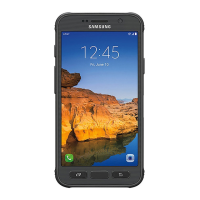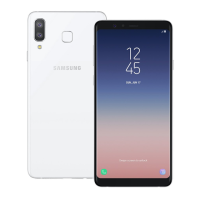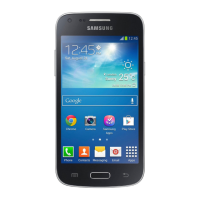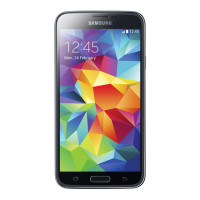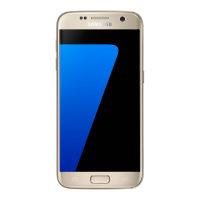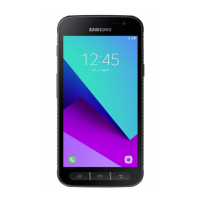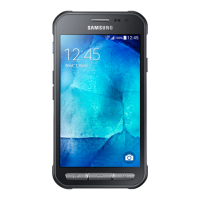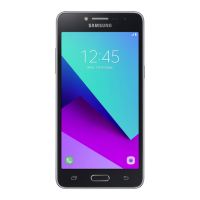Do you have a question about the Samsung SM-G800F and is the answer not in the manual?
Lists the items included in the product box for your device.
Diagrams identifying the external buttons, ports, and sensors of the device.
Step-by-step instructions for inserting the SIM or USIM card and battery.
Instructions on how to connect the device to a power source for charging.
Explains basic touch screen interactions like tapping, dragging, and pinching.
Overview of the device's home screen, widgets, apps, and folders.
How to access and use the notification panel and quick settings.
How to connect to a mobile network for internet access and data sharing.
Steps to connect to Wi-Fi networks and manage saved networks.
Using the device to share its mobile data connection with other devices.
Customizing the home screen, adding/removing items, and managing app screens.
Instructions for changing the device's wallpaper and notification sounds.
Registering and managing fingerprints for device security and authentication.
How to use Private mode to hide personal content and secure data.
Detailed steps for making, answering, and rejecting voice and video calls.
Features available during an active voice or video call, like mute, speaker, and hold.
Methods for creating, editing, deleting, and sharing contact information.
Creating, adding contacts to, and deleting groups of contacts.
Instructions for composing, sending, and viewing text and multimedia messages.
Guide to configuring email accounts for sending and receiving emails.
How to take photos and record videos using various camera modes.
Overview of available camera settings for photos and videos.
Accessing, viewing, and editing images and videos using the Gallery app.
Instructions for playing music, creating playlists, and managing music settings.
How to play videos, use the pop-up player, and trim video segments.
Guide to creating a user profile and entering personal health statistics.
Tracking steps, distance, and burnt calories using the device's pedometer.
Recording exercise information, tracking progress, and using coaching features.
Logging daily food intake and managing calorie consumption.
How to activate Emergency mode to extend standby time during emergencies.
Setting up primary contacts and messages for emergency situations.
Receiving alerts for severe weather conditions based on your location.
Providing a safe environment for children by restricting app and content access.
Searching for content on the device and managing search history.
Managing events and tasks, syncing with accounts, and setting reminders.
Controlling the device and performing tasks using voice commands.
Pairing with Bluetooth devices and sharing data wirelessly.
Connecting devices directly via Wi-Fi without an access point.
Using NFC for payments, reading tags, and sending data via Android Beam.
Displaying your device's screen on a larger screen like a TV.
Instructions for updating the device's software over the air or via PC.
Moving files between the device and a computer using USB connection.
How to back up and restore device data using Google or Samsung accounts.
Steps to perform a factory data reset, erasing all settings and data.
Configuring network settings like Wi-Fi, Bluetooth, and mobile data.
Adjusting volume, ringtones, screen brightness, font, and display modes.
Customizing device modes like Easy mode, Accessibility, Blocking, and Private mode.
Changing display language, keyboard settings, and voice input options.
Enabling and using TalkBack for screen reading and voice feedback.
Magnifying the screen, adjusting zoom, and using finger gestures for navigation.
Reversing display colors, adjusting color balance, and mono audio settings.
Using the assistive menu, cursor control, and interaction control features.
Resolving issues with device codes (PIN, PUK) and network reception.
Troubleshooting steps for device power issues and freezing or fatal errors.
Resolving issues with call audio, network disconnections, and poor signal quality.
Addressing problems with battery charging, depletion, and temperature.
Lists the items included in the product box for your device.
Diagrams identifying the external buttons, ports, and sensors of the device.
Step-by-step instructions for inserting the SIM or USIM card and battery.
Instructions on how to connect the device to a power source for charging.
Explains basic touch screen interactions like tapping, dragging, and pinching.
Overview of the device's home screen, widgets, apps, and folders.
How to access and use the notification panel and quick settings.
How to connect to a mobile network for internet access and data sharing.
Steps to connect to Wi-Fi networks and manage saved networks.
Using the device to share its mobile data connection with other devices.
Customizing the home screen, adding/removing items, and managing app screens.
Instructions for changing the device's wallpaper and notification sounds.
Registering and managing fingerprints for device security and authentication.
How to use Private mode to hide personal content and secure data.
Detailed steps for making, answering, and rejecting voice and video calls.
Features available during an active voice or video call, like mute, speaker, and hold.
Methods for creating, editing, deleting, and sharing contact information.
Creating, adding contacts to, and deleting groups of contacts.
Instructions for composing, sending, and viewing text and multimedia messages.
Guide to configuring email accounts for sending and receiving emails.
How to take photos and record videos using various camera modes.
Overview of available camera settings for photos and videos.
Accessing, viewing, and editing images and videos using the Gallery app.
Instructions for playing music, creating playlists, and managing music settings.
How to play videos, use the pop-up player, and trim video segments.
Guide to creating a user profile and entering personal health statistics.
Tracking steps, distance, and burnt calories using the device's pedometer.
Recording exercise information, tracking progress, and using coaching features.
Logging daily food intake and managing calorie consumption.
How to activate Emergency mode to extend standby time during emergencies.
Setting up primary contacts and messages for emergency situations.
Receiving alerts for severe weather conditions based on your location.
Providing a safe environment for children by restricting app and content access.
Searching for content on the device and managing search history.
Managing events and tasks, syncing with accounts, and setting reminders.
Controlling the device and performing tasks using voice commands.
Pairing with Bluetooth devices and sharing data wirelessly.
Connecting devices directly via Wi-Fi without an access point.
Using NFC for payments, reading tags, and sending data via Android Beam.
Displaying your device's screen on a larger screen like a TV.
Instructions for updating the device's software over the air or via PC.
Moving files between the device and a computer using USB connection.
How to back up and restore device data using Google or Samsung accounts.
Steps to perform a factory data reset, erasing all settings and data.
Configuring network settings like Wi-Fi, Bluetooth, and mobile data.
Adjusting volume, ringtones, screen brightness, font, and display modes.
Customizing device modes like Easy mode, Accessibility, Blocking, and Private mode.
Changing display language, keyboard settings, and voice input options.
Enabling and using TalkBack for screen reading and voice feedback.
Magnifying the screen, adjusting zoom, and using finger gestures for navigation.
Reversing display colors, adjusting color balance, and mono audio settings.
Using the assistive menu, cursor control, and interaction control features.
Resolving issues with device codes (PIN, PUK) and network reception.
Troubleshooting steps for device power issues and freezing or fatal errors.
Resolving issues with call audio, network disconnections, and poor signal quality.
Addressing problems with battery charging, depletion, and temperature.
| Model | SM-G800F |
|---|---|
| Category | Cell Phone |
| SIM | Micro-SIM |
| Protection | Corning Gorilla Glass 3 |
| OS | Android 4.4.2 (KitKat), upgradable to 5.1.1 (Lollipop) |
| CPU | Quad-core 1.2 GHz Cortex-A7 |
| GPU | Adreno 305 |
| RAM | 1.5 GB |
| Internal Storage | 16 GB |
| Card slot | microSDXC (dedicated slot) |
| Features | LED flash, panorama, HDR |
| Video | 1080p@30fps |
| Loudspeaker | Yes |
| 3.5mm jack | Yes |
| WLAN | Wi-Fi 802.11 a/b/g/n, dual-band, Wi-Fi Direct, hotspot |
| Bluetooth | 4.0, A2DP, LE |
| GPS | Yes, with A-GPS, GLONASS |
| NFC | Yes |
| Infrared port | No |
| Radio | FM radio |
| USB | microUSB 2.0 |
| Network | GSM / HSPA / LTE |
| Display Type | Super AMOLED |
| Resolution | 720 x 1280 pixels |
| Chipset | Qualcomm Snapdragon 400 |
| Main Camera | 8 MP |
| Sensors | Accelerometer, proximity |
| Battery | 2100 mAh |
| Colors | White, Gold |
| Expandable Storage | Yes |
